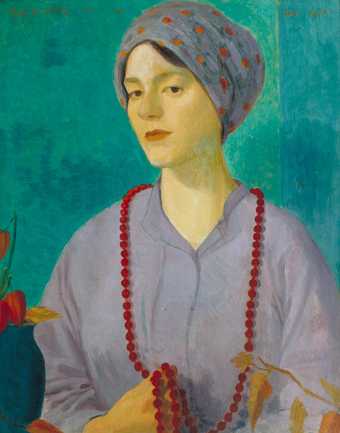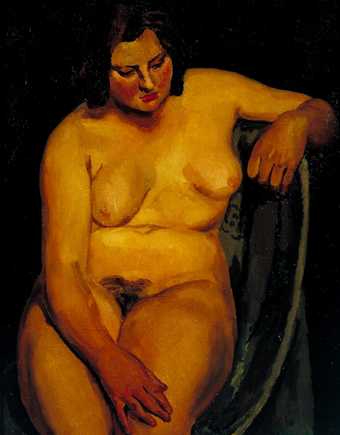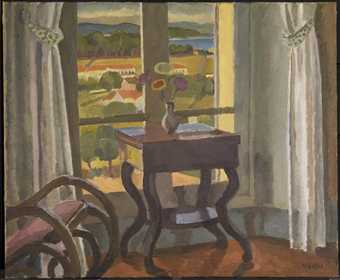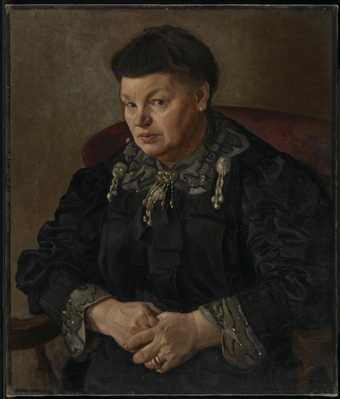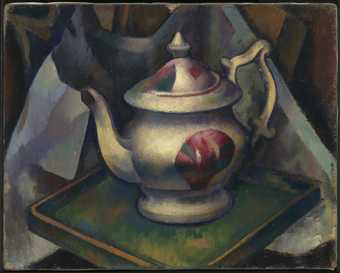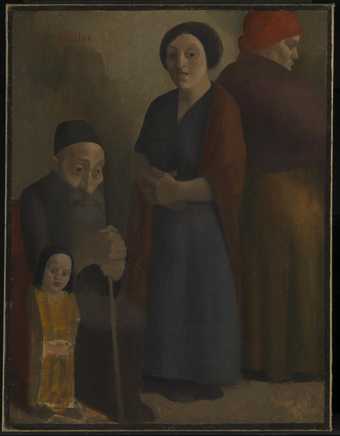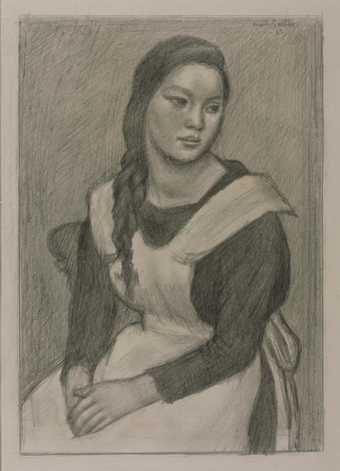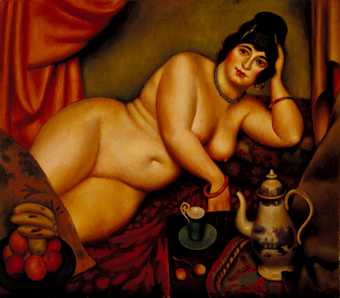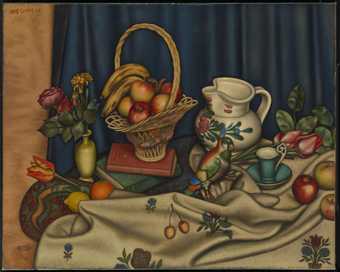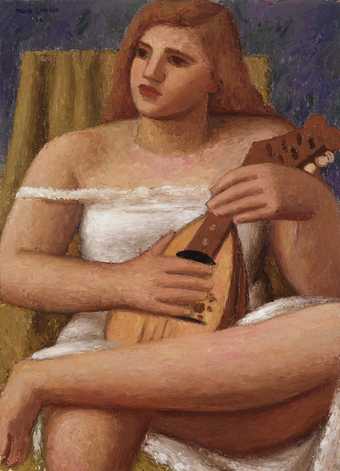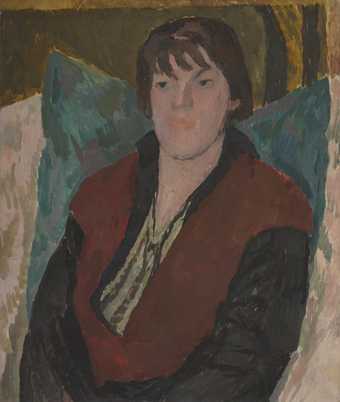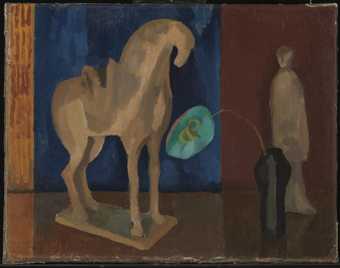
In Tate Britain
- Artist
- Mark Gertler 1891–1939
- Medium
- Oil paint on canvas
- Dimensions
- Support: 1892 × 1422 mm
frame: 2100 × 1620 × 75 mm - Collection
- Tate
- Acquisition
- Purchased 1984
- Reference
- T03846
Summary
Gertler lived near Hampstead Heath from the winter of 1914-15. The roundabout at the annual fair may have provided an inspiration for this picture. His painting from the spring of 1915 titled Swing Boats (now lost, reproduced Woodeson, pl.28) is probably also of this fair. A letter from the writer D.H. Lawrence to Zoe Akins of 15 September 1915 describes a special fair then on the Heath (Zytaruk and Boulton, eds., The Letters of D.H. Lawrence, II, Cambridge 1981, p.396): 'There is a fair on behalf of the wounded soldiers today, and myriads of the wounded, in their bright blue uniforms and red scarves, and bands, and swing boats, and a whole rowdy enjoyment. It is queer.' Both the colours, and his remarking the odd contrast between wounded soldiers and public enjoyment, connect this comment with his friend Gertler's painting.
Gertler was a close friend of the young Richard Carline at this time and presumably knew his studies of roundabouts made in early 1915. As far as is known, no paintings of the subject by Richard Carline survive, but his elder brother Sydney's 1915 Bank Holiday on Hampstead Heath is in the Tate Gallery (Tate Gallery T01997). This painting is not of the fairground but it also has stylised figures and design.
In several paintings and drawings preceding Merry-Go-Round Gertler had hardened the figures into geometrical shapes, at times giving them the appearance of dolls (see, for instance, Family Group, 1913, Southampton City Art Gallery; Rabbi and Rabbitzin, 1914, private collection). The Tate's painting was begun by May 1916 when Gertler wrote to Lytton Strachey, 'I am working very hard on a large and very unsaleable picture of "Merry-Go-Round"' (Carrington, p.111). Gertler's biographer John Woodeson states that it was finished by the following autumn.
Several of the figures in the painting wear uniform but, although it is understood today as an expression of horror at the war, this is surprisingly not made explicit in either private or public comments of the time. Lawrence was deeply affected by the painting but, although recognising Gertler's anguish, related it to the artist's Jewish roots rather than to the war. In a letter to Gertler of 9 October 1916, Lawrence writes:
Your terrible and dreadful picture has just come. This is the first picture you have ever painted: it is the best modern picture I have seen ... I believe there was something in Pompeian art, of this terrible and soul-tearing obscenity ... I could sit down and howl beneath it like Kot's dog, in soul-lacerating despair. I realise how superficial your human relationships must be, what a violent maelstrom of destruction and horror your inner soul must be ... it would take a Jew to paint this picture. It would need your national history to get you here, without disintegrating you first ... You are twenty-five, and have painted this picture - I tell you, it takes three thousand years to get where this picture is - and we Christians haven't got two thousand years behind us yet.Gertler had written to his patron Edward Marsh in the preceding summer: 'I am I believe what you call a "passivist". I don't know exactly what that means, but I just hate the war' (in C. Hassall, Edward Marsh, London 1959, p.370). It is difficult now not to regard the Merry-Go-Round as an expression of this hatred but the numerous reviews of the 1917 London Group exhibition - by which time the news of the war was even worse - make no reference to this idea. It was regarded as the most striking painting in the exhibition but even the favourable descriptions did not take it to be a serious work. The painting was regarded in the first place as a provocative example of modernity in art and secondly as a decoration, intending no more than a description of a fun fair. The Sunday Times (29 April 1917) called it 'the apotheosis of the steam organ in paint, and a style of decoration admirably fitted for the adornment of a popular restaurant'.
(Zytaruk and Boulton, eds., II, 1981, pp.660-1)
Further reading:
Noel Carrington (ed.), Mark Gertler, Selected Letters, London 1965, pp.11, 111-12, 128-33, 138, pl.10
John Woodeson, Mark Gertler, Biography of a Painter, London 1971, pp.207-247, 250, 339, 341, 343-5, reproduced pl.26
The Tate Gallery 1984-86: Illustrated Catalogue of Acquisitions, London 1988, p.153-5, reproduced
Terry Riggs
February 1998
Does this text contain inaccurate information or language that you feel we should improve or change? We would like to hear from you.
Display caption
This work was painted at the height of the First World War, which seems to be its subject. Men and women in rigid poses, their mouths crying in silent unison, seem trapped on a carousel that revolves endlessly. Gertler was a conscientious objector. He lived near London’s Hampstead Heath, and may have been inspired by an annual fair held there for wounded soldiers. The fairground ride, traditionally associated with pleasure and entertainment, is horrifically transformed into a metaphor for the relentless military machine. He explained, ‘Lately the whole horror of war has come freshly upon me’.
Gallery label, September 2016
Does this text contain inaccurate information or language that you feel we should improve or change? We would like to hear from you.
Catalogue entry
Mark Gertler 1891-1939
T03846 Merry-Go-Round
1916
Oil on canvas 1892 x 1422 (74 1/2 x 56)
Inscribed ‘Merry-Go-Round | 1916 | Mark Gertler' on back of canvas t.r.
Purchased from Ben Uri Art Society (Grant-in-Aid) 1984
Prov: ...; Leicester Galleries; given by the Directors of Leicester Galleries to the Ben Uri Art Society 1945
Exh: London Group, Mansard Gallery, April-May 1917 (52); London Group, New Burlington Galleries, May 1928 (62, repr.); Mark Gertler, Memorial Exhibition, Leicester Galleries, May-June 1941 (14); Paintings and Drawings by Mark Gertler, Ben Uri Art Gallery, Nov.-Dec. 1944 (52); Mark Gertler, Memorial Exhibition, Whitechapel Art Gallery, June-July 1949 (18 as ‘The Roundabout'); Mark Gertler, Ben Uri Art Gallery, Summer 1957 (8); Some Twentieth Century Jewish Artists, Leicestershire Museum and Art Gallery, June-July 1963 (18); 1914-64, London Group Jubilee Exhibition: Fifty Years of British Art, Tate Gallery, July-Aug. 1964 (37, repr.); Decade 1910-20, AC tour, Leeds City Art Gallery, May 1965, Reading Art Gallery, May-June 1965, Manchester City Art Gallery, July 1965, Art Gallery and Museum, Glasgow, July-Aug. 1965, Leicester Museum and Art Gallery, Sept. 1965 (88); L'Art en Europe autour de 1918, Council of Europe, Ancienne Douane, Strasbourg, May-Sept. 1968 (65, as ‘Le Manège, [The Roundabout ou Merry go round]'); Narrative Painting in Britain in the 20th Century, Camden Arts Centre, Feb.-March 1970 (21); British Art 1890-1928, Columbus Gallery of Fine Arts, Columbus, Ohio, Feb.-March 1971 (27, repr.); Mark Gertler, 1891-1939, The Minories, Colchester, March-April 1971 (17); Jewish Artists of Great Britain 1845-1945, Belgrave Gallery, March-April 1978 (30); Jewish Art: Paintings and Sculptures by 20th Century Jewish Artists of the French and British Schools, Art Gallery and Museum, Glasgow, Sept.-Oct. 1979 (36); Mark Gertler, the Early and Late Years, Ben Uri Art Gallery, March-May 1982 (27, repr. on cover in col.); British Art in the 20th Century, The Modern Movement, RA, Jan.-April 1987 (74, repr. p.172 in col.)
Lit: John Rothenstein, Modern English Painters, 1952, 1984 ed., II, p.134; Noel Carrington (ed.), Mark Gertler, Selected Letters, 1965, pp.11, 111-12, 128-33 and 138, pl.10; John Woodeson, Mark Gertler, Biography of a Painter, 1971, pp.222, 250, 339, 341 and 343-5, repr. p.26; Richard Shone, The Century of Change: British Painting since 1900, 1977, p.21, pl.50; Dennis Farr, English Art 1870-1940, 1978, pp.234-5, pl.86a; John Ferguson, The Arts In Britain in World War 1, 1980, p.73, repr. I and front cover (col.); Charles Harrison, English Art and Modernism 1900-1939, 1981, p.151 repr.; George J. Zytaruk and James T. Boulton (eds.), The Letters of D.H. Lawrence, II, June 1913-October 1916, 1981, pp.657, 660-1, 668; Frances Spalding, ‘Mark Gertler - the Early Years' in Mark Gertler - the Early and Late Years, exh. cat., Ben Uri Art Gallery, 1982, p.5, repr on front cover (col.); Alison Beckett, ‘Fury over Gertler Action', Daily Telegraph, 28 Feb. 1984, p.14; Geraldine Norman, ‘Gallery cancels plan to auction picture', The Times, 7 March 1984; Christies, 9 March 1984, lot 74, repr. in col.; New Acquisitions, Tate Gallery, Summer 1984, repr.; Frances Spalding, D.H. Lawrence and the Visual Arts, exh. cat., Castle Museum, Nottingham, Sept.-Oct. 1985, p.15; Dannie Abse, ‘The Merry-Go-Round at Night' in Pat Adams (ed.), With a Poet's Eye. A Tate Gallery Anthology, 1986, p.82 repr.; Tate Gallery Report 1984-6, 1986, pp.71-2 repr. (col.); Frances Spalding, British Art Since 1900, 1986, p.58, repr. p.47 (col.); Frederick Gore, ‘The Resilient Figure: Mark Gertler and Matthew Smith', British Art in the 20th Century, The Modern Movement, exh. cat., RA, 1987, p.172 repr. (col.). Also repr: Studio, vol.154, Oct.1957, p.126; Studio, vol.163, June 1962, p.220; Sunday Times Colour Magazine, 11 Jan. 1987 on cover.
John Woodeson suggests that Gertler recalled for this painting a roundabout in the annual fair on Hampstead Heath, near where he had lived from the winter of 1914-15. His painting from the spring of 1915 titled ‘Swing Boats' is probably also of this fair but is lost (repr. Woodeson 1971, pl.28). A letter from D.H. Lawrence to Zoe Akins of 15 September 1915 describes a special fair then on the Heath that may also be relevant (Zytaruk and Boulton (eds.) 1981, p.396). Lawrence wrote: ‘There is a fair on behalf of the wounded soldiers today, and myriads of the wounded, in their bright blue uniforms and red scarves, and bands, and swing boats, and a whole rowdy enjoyment. It is queer'. Both the colours, and his remarking the odd contrast between wounded soldiers and public enjoyment, connect this comment with his friend Gertler's painting.
Gertler was a close friend of the young Richard Carline at this time and presumably knew his studies of roundabouts made in early 1915. Stanley Spencer singled these out from his work writing, ‘they give me the most extraordinary feelings' (letter to Richard Carline, 2 May 1915, Tate Gallery Archive). So far as is known no paintings of the subject by Richard Carline survive, but his elder brother Sydney's ‘Bank Holiday on Hampstead Heath' (1915, T01997, oil on canvas, 839 x 815, 33 x 32), belongs to the Tate Gallery. This painting is not of the fairground but it also has stylised figures and design.
In several paintings and drawings preceding ‘Merry-Go-Round' Gertler had hardened the figures into geometrical shapes, at times giving them the appearance of dolls. He had been a close friend of Bomberg for some years but, in comparison with his work, Gertler's own had remained naturalistic in style. A precedent both for subject and treatment for ‘Merry-Go-Round' lay in recent paintings by Nevinson who had returned from the war in France in January 1916. Although Nevinson and Gertler were at the Slade together between 1908 and 1912, it is not recorded that they then were well acquainted; as respectively anti and pro ‘Bloomsbury' they may have been personally at odds. However, Nevinson's colouring and application of paint and the use of geometry to express violence (as in his ‘Bursting Shell' T03676), which was shown at the London Group in November 1915), are comparable to ‘Merry-Go-Round' in spite of the difference in scale of his paintings. Nevinson's large painting ‘Tim-Tiddly-Um-Tum-Pom-Pom' exhibited at the Allied Artist's Salon in 1914 (lost, repr. R. Cork, Vorticism and Abstract Art in the First Machine Age, 1976, Vol.1, p.220) shows crowds on Hampstead Heath on a Bank Holiday, but it does not have the tight design of his paintings of the following years.
The painting was begun by May 1916 when Gertler wrote to Lytton Strachey, ‘I am working very hard on a large and very unsaleable picture of "Merry-Go-Round"' (Noel Carrington, Selected Letters of Mark Gertler, 1965, p.111). Woodeson states that it was finished by the following autumn.
Several of the figures in the painting wear uniform but, although it is understood today as an expression of horror at the war, this is surprisingly not made explicit in either private or public comments of the time. Woodeson quotes letters from the artist's friend Lytton Strachey: ‘I felt that if I were to look at it for any length of time I should be taken away suffering from shell shock' (Woodeson 1971, p.226) and from D.H.Lawrence: ‘Ghastly, utterly mindless human intensity of sensational extremity' (ibid., p.226), neither of whom made the direct comparison between the figures and people either taking part in or supporting the war.
Lawrence continues in his letter (Zytarak and Boulton (eds.) 1981, pp.660-1) to connect the painting with Gertler's ‘human relationships', which he saw as superficial in comparison to the violence in his soul, and also to his being a Jew.
Gertler's own attitude to the war is known. In 1916 he was aged twenty-five and was threatened with conscription. He was a pacifist and is likely to have been considering declaring himself a conscientious objector, as had some of his friends in the circle of Lady Ottoline Morrell. The reason that he had given to his patron Edward Marsh in the preceding summer for breaking his connection with him was that their attitudes to the war were so different: ‘I am I believe what you call a "passivist". I don't know exactly what that means, but I just hate the war' (in Christopher Hassall, Edward Marsh, 1959, p.370, letter of 19 August 1915).
It is impossible now not to regard the ‘Merry-Go-Round' as an expression of this hatred but the numerous reviews of the 1917 London Group exhibition - by which time the news of the war was even worse - make no reference to this idea. It was regarded as the most striking painting in the exhibition but even the favourable descriptions did not take it to be a serious work. The painting was regarded in the first place as a provocative example of modernity in art and secondly as a decoration, intending no more than a description of a fun fair.
In November 1916 Gertler was working on a ‘Carving of the Merry-Go-Round' (Woodeson 1971, p.234). At the London Group exhibition he also showed ‘Sculpture, The Acrobats' (94), which was coloured blue, according to reviews, and described as ‘the sculptured and equally crudely coloured group of contortionist acrobats'. This was presumably a plaster cast of the Tate Gallery's bronze ‘Acrobats' (N 06033), to which ‘Merry-Go-Round' is similar in its repetition of figures arranged in a circle. The sculpture is also similar to Gertler's next major painting ‘Bathers' (Sotheby's, 15 May 1985 (109); repr. RA exh. cat., 1987, p.175 pl.76, in col.; composition drawing reproduced in New Paths, 1917-18, p.131), which although geometrical was painted more loosely and with less harsh colours.
The stretcher of ‘Merry-Go-Round' was altered while it was being painted and nail holes show that it was lengthened at the lower edge by about two inches, presumably in order to fit in the bottom of the roundabout. The back of the canvas is covered with dabs of paint, as if the artist had been trying out colours while this painting was stretched and placed face to the studio wall. The inscription on the reverse was painted over these colours.
A preparatory drawing used for some of the heads is dated ‘Mark Gertler | 1915' (repr. British and French, Browse and Darby, June-July 1984 (9), where it is said to have been purchased from the artist by John Drinkwater in 1915). This drawing was begun with a portrait head in the lower right corner, probably of Gertler's sister Sophie (by comparison to ‘The Fruit Sorters', 1914, Leicester Museum and Art Gallery, repr. Leicester Museums and Art Gallery: Collection of Paintings, permanent collection catalogue, 1958, no. 14F), which was not used for this painting. Also on the pages are two further heads of a man and a woman, each drawn twice and with geometrical precision. The man's pose is similar to that of one of the groups of merry-go-round riders and the repetition of the pairs of heads is like the repetition of the three riders in each group.
It is not known when the Leicester Galleries acquired the painting, but they lent many of the exhibits to the 1944 exhibition at the Ben Uri Gallery. In 1984 the Ben Uri Art Society arranged for the painting to be sold at Christies but it was subsequently withdrawn.
Published in:
The Tate Gallery 1984-86: Illustrated Catalogue of Acquisitions Including Supplement to Catalogue of Acquisitions 1982-84, Tate Gallery, London 1988, pp.153-5
Features
Explore
- abstraction(8,615)
-
- from recognisable sources(3,634)
- places of entertainment(637)
-
- fairground(26)
- music and entertainment(2,331)
-
- fair(46)
- clothing and personal items(5,879)
-
- hat, bonnet(211)
- hat, cap(336)
- carousel(8)
- actions: expressive(2,622)
-
- grimacing(75)
- crowd(646)
- UK countries and regions(24,355)
-
- England(19,202)
- social comment(6,584)
-
- caricature(355)
- machine age(49)
- militarism(591)
You might like
-
Mark Gertler Portrait of a Girl
1912 -
Vanessa Bell Chrysanthemums
1920 -
Vanessa Bell Nude
c.1922–3 -
Vanessa Bell Interior with a Table
1921 -
Mark Gertler The Servant Girl
1923 -
Mark Gertler The Artist’s Mother
1911 -
Mark Gertler The Tea Pot
1918 -
Mark Gertler Jewish Family
1913 -
Mark Gertler Sketch for ‘The Servant Girl’
1923 -
Roger Fry Still Life: Flowers
c.1912 -
Mark Gertler Queen of Sheba
1922 -
Mark Gertler The Basket of Fruit
1925 -
Mark Gertler Mandolinist
1934 -
Vanessa Bell Helen Dudley
c.1915 -
Roger Fry Still Life with T’ang Horse
c.1919–21

